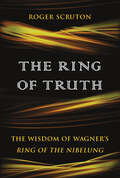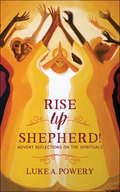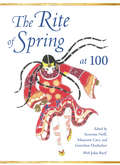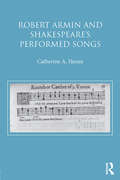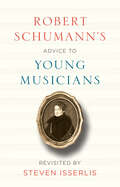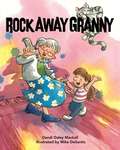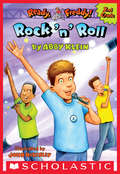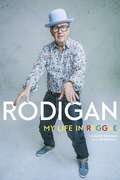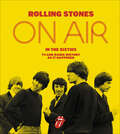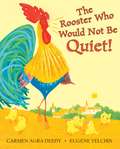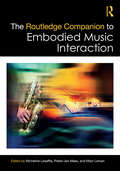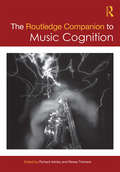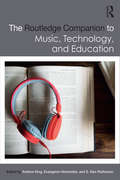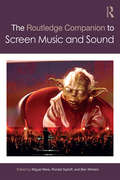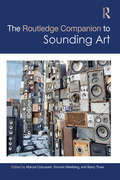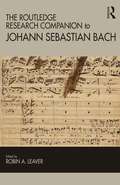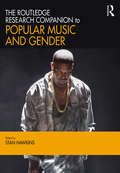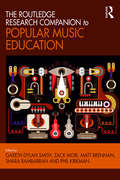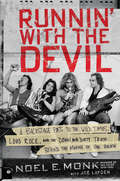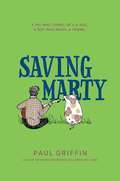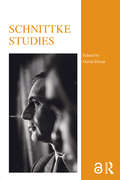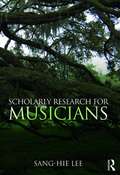- Table View
- List View
The Ring of Truth: The Wisdom of Wagner's Ring of the Nibelung
by Roger ScrutonThe vital, carefully crafted discussion on Wagner’s masterpiece, offering deep insight into both the work itself and profound perspective on certain key philosophical questions Richard Wagner’s Ring of the Nibelung is one of the greatest works of art created in modern times, and has fascinated both critics and devotees for over a century and a half. No recent study has examined the meaning of Wagner's masterpiece with the attention to detail and intellectual power that Roger Scruton brings to it in this inspiring account. The Ring of Truth is an exploration of the drama, music, symbolism and philosophy of the Ring from a writer whose knowledge and understanding of the Western musical tradition are the equal of his capacities as a philosopher. Scruton shows how, through musical connections and brilliant dramatic strokes, Wagner is able to express truths about the human condition which few other creative artists have been able to convey so convincingly. For Wagner, writes Scruton, the task of art is to “show us freedom in its immediate, contingent, human form, reminding us of what it means to us. Even if we live in a world from which gods and heroes have disappeared we can, by imagining them, dramatize the deep truths of our condition and renew our faith in what we are.” Love, death, sacrifice and the liberation that we win through sacrifice—these are the great themes of the Ring, as they are of this book. Scruton's passionate and moving interpretation allows us to understand more fully than ever how Wagner conveys his ideas about who we are, and why the Ring continues to be such a hypnotically absorbing work.
Rise Up, Shepherd!: Advent Reflections On The Spirituals
by Luke A. PoweryValuable not only for their sublime musical expression, the African American spirituals give us profound insights into the human condition and the Christian life. Many focus on an essential scene of the Christian drama: the coming of God as the child in Bethlehem and as the hope of the world and the liberator of God's oppressed people. <P><P>In these devotions for the season of Advent, Luke Powery leads the reader through the spirituals as they confront the mystery of incarnation and redemption. In Rise Up, Shepherd! each devotion features the lyrics of the spiritual, a reflection on the spiritual's meaning, a Scripture verse, and a brief prayer.
The Rite of Spring at 100
by Stephen Walsh Severine Neff Maureen Carr John Reef Gretchen HorlacherWhen Igor Stravinsky's ballet Le Sacre du printemps (The Rite of Spring) premiered during the 1913 Paris season of Sergei Diaghilev's Ballets Russes, its avant-garde music and jarring choreography scandalized audiences. Today it is considered one of the most influential musical works of the twentieth century. In this volume, the ballet finally receives the full critical attention it deserves, as distinguished music and dance scholars discuss the meaning of the work and its far-reaching influence on world music, performance, and culture. Essays explore four key facets of the ballet: its choreography and movement; the cultural and historical contexts of its performance and reception in France; its structure and use of innovative rhythmic and tonal features; and the reception of the work in Russian music history and theory. This version also includes audio and visual supplements designed to enhance understanding of this classic piece.
The Rite of Spring at 100
by Gretchen Horlacher John Reef Maureen Carr Severine Neff Stephen WalshWhen Igor Stravinsky's ballet Le Sacre du printemps (The Rite of Spring) premiered during the 1913 Paris season of Sergei Diaghilev's Ballets Russes, its avant-garde music and jarring choreography scandalized audiences. Today it is considered one of the most influential musical works of the twentieth century. In this volume, the ballet finally receives the full critical attention it deserves, as distinguished music and dance scholars discuss the meaning of the work and its far-reaching influence on world music, performance, and culture. Essays explore four key facets of the ballet: its choreography and movement; the cultural and historical contexts of its performance and reception in France; its structure and use of innovative rhythmic and tonal features; and the reception of the work in Russian music history and theory.
Robert Armin and Shakespeare's Performed Songs
by Catherine A. HenzeAfter Robert Armin joined the Chamberlain's Men, singing in Shakespeare's dramas catapulted from 1.25 songs and 9.95 lines of singing per play to 3.44 songs and 29.75 lines of singing, a virtually unnoticed phenomenon. In addition, many of the songs became seemingly improvisatory—similar to Armin's personal style as an author and solo comedian. In order to study Armin's collaborative impact, this interdisciplinary book investigates the songs that have Renaissance music that could have been heard on Shakespeare's stage. They occur in some of Shakespeare's most famous plays, including Much Ado About Nothing, Twelfth Night, Hamlet, and The Tempest. In fact, Shakespeare's plays, as we have them, are not complete. They are missing the music that could have accompanied the plays’ songs. Significantly, Renaissance vocal music, far beyond just providing entertainment, was believed to alter the bodies and souls of both performers and auditors to agree with its characteristics, directly inciting passions from love to melancholy. By collaborating with early modern music editor and performing artist Lawrence Lipnik, Catherine Henze is able to provide new performance editions of seventeen songs, including spoken interruptions and cuts and rearrangement of the music to accommodate the dramatist's words. Next, Henze analyzes the complete songs, words and music, according to Renaissance literary and music primary sources, and applies the new information to interpretations of characters and scenes, frequently challenging commonly held literary assessments. The book is organized according to Armin's involvement with the plays, before, during, and after the comic actor joined Shakespeare's company. It offers readers the tools to interpret not only these songs, but also vocal music in dramas by other Renaissance playwrights. Moreover, Robert Armin and Shakespeare's Performed Songs, written with non-specialized terminology, provides a gateway to new areas of research and interpretation in an increasingly significant interdisciplinary field for all interested in Shakespeare and early modern drama.
Robert Schumann's Advice to Young Musicians: Revisited by Steven Isserlis
by Robert Schumann Steven IsserlisIf everybody were to play first violin, we could not have an orchestra. Therefore respect each musician in his own place. There is no end to learning. Originally published in1850, Advice to Young Musicians: Musical Rules for Home and in Life offered composer Robert Schumann’s (1810–56) combination of practical advice and poetic words of wisdom for young people beginning their musical education. Presented in aphorisms and short paragraphs, the book’s insights remain as valuable today as when it was written. Recognizing the continued resonance of Schumann’s words, world-renowned cellist Steven Isserlis, himself a writer of children’s books and many articles for young musicians, set out to rescue the work from history. Here, in this beautiful gift edition, he revisits Schumann’s work and contributes his own contemporary counsel for musicians and music lovers. For this edition, Isserlis retranslated Schumann’s text and arranged it into four thematic sections: “On being a musician,” “Playing,” “Practicing,” and “Composing.” Each page is decoratively designed, and accompanying Schumann’s original quotation are Isserlis’s thoughtful and often humorous glosses. The book concludes with Isserlis’s own reflections on his life as a musician and performer: “My Own Bits of Advice (For What They’re Worth).” The result is a unique and thought-provoking book that will be treasured by aspiring musicians of any age.
Rock Away Granny
by Dandi Daley Mackall Mike DeSantisGetting dropped off at Grandma’s house could be a total snooze. Hours of sitting in the rocking chairs. But not this Grandma. Up she hops to wheel out the record player. And then, with kitty as the DJ—a dance party! The twist, the swing, the Monster Mash—they rock, rock, rock, at Granny’s house tonight. Then right as Mom returns, everyone crashes out in the rocking chairs. Just another boring night at Grandma’s (Mom thinks). Wink!Includes pictures of easy to follow dance steps like the side pass, cuddle, and underarm turn.
Rock'n'Roll (Ready, Freddy! 2nd Grade #8)
by Abby Klein John MckinleyFreddy's favorite band is having a contest -- make a video of their new song and win tickets and backstage passes to the concert! There's going to be so much competition, though. Freddy definitely needs help from his friends, and maybe even ... his sister?
Rodigan: My Life in Reggae
by David Rodigan'THE BOOK THAT EVERY REGGAE FAN SHOULD READ' John Masouri, Echoes'Rodigan can still claim a currency few presenters of his vintage can match. Perhaps it's because while his wider musical and professional milieu has been in constant change, his boundless enthusiasm has been constant. Reggae's been lucky to have him' Ian Harrison, MOJO'Rodigan was a major part of my childhood, he played the hottest tunes and in a style that just resonated with me and millions like me. Being able to contribute anything to a man that filled my life with such joy is an honour, respect, David Rodigan' Ian Wright'David is a pioneer in Reggae music. As a selector and radio personality, his vast knowledge of Jamaican music and its culture has helped to educate and fascinate music lovers around the world; he's an amazing son of the music, and an icon. We couldn't have made it this far without him' ShaggyThis is the unlikely story of David Rodigan: an Army sergeant's son from the English countryside who has become the man who has taught the world about Reggae. As the sound of Jamaica has morphed over five decades through a succession of different genres - from Ska and Rock Steady, to Dub, Roots and Dancehall - Rodigan has remained its constant champion, winning the respect of generation after generation of Reggae followers across the globe.Today, at the age of 63, he is a headline performer at almost all the UK's big music festivals, as well as events across the world. Young people revere him and he is a leading presenter on the BBC's youth network 1Xtra as well as a regular fixture at leading nightclubs such as London's Fabric and at student unions throughout the land. And he continues to go into the heartlands of Reggae, to the downtown dancehalls of Kingston and Montego Bay in Jamaica to compete in tournaments against the greatest sound systems. And yet, for all of this, David Rodigan is the antithesis of the stereotype of an international dance music DJ. 'I look like an accountant or a dentist,' he admitted to The Independent a decade ago. A man of impeccable manners, Rodigan prepares for a big sound clash by retiring to his hotel bed with a Thomas Hardy novel before taking a nap and then a cup of espresso before heading to the club. Rodigan is the inside story of this apparent paradox. It tells how a boy from Kidlington has become an admired international ambassador for a music form that remains as proud as ever of its African roots, a sound that emanates from and fiercely represents the ghetto poor. He now reaches across the age groups, from teens through to those of his own vintage. At the pinnacle of his career, Rodigan has become the DJ for all generations.'David Rodigan is a force of nature. His spirit and passion are a rare and wonderful thing. He has dedicated his life to carrying the torch for Reggae music and is hugely respected all over the world for his knowledge and talent as a broadcaster and a DJ. Long may he reign on our stages and on our airwaves' Annie Mac
Rodigan: My Life in Reggae
by David Rodigan'THE BOOK THAT EVERY REGGAE FAN SHOULD READ' John Masouri, Echoes'Rodigan can still claim a currency few presenters of his vintage can match. Perhaps it's because while his wider musical and professional milieu has been in constant change, his boundless enthusiasm has been constant. Reggae's been lucky to have him' Ian Harrison, MOJO'Rodigan was a major part of my childhood, he played the hottest tunes and in a style that just resonated with me and millions like me. Being able to contribute anything to a man that filled my life with such joy is an honour, respect, David Rodigan' Ian Wright'David is a pioneer in Reggae music. As a selector and radio personality, his vast knowledge of Jamaican music and its culture has helped to educate and fascinate music lovers around the world; he's an amazing son of the music, and an icon. We couldn't have made it this far without him' ShaggyThis is the unlikely story of David Rodigan: an Army sergeant's son from the English countryside who has become the man who has taught the world about Reggae. As the sound of Jamaica has morphed over five decades through a succession of different genres - from Ska and Rock Steady, to Dub, Roots and Dancehall - Rodigan has remained its constant champion, winning the respect of generation after generation of Reggae followers across the globe.Today, at the age of 63, he is a headline performer at almost all the UK's big music festivals, as well as events across the world. Young people revere him and he is a leading presenter on the BBC's youth network 1Xtra as well as a regular fixture at leading nightclubs such as London's Fabric and at student unions throughout the land. And he continues to go into the heartlands of Reggae, to the downtown dancehalls of Kingston and Montego Bay in Jamaica to compete in tournaments against the greatest sound systems. And yet, for all of this, David Rodigan is the antithesis of the stereotype of an international dance music DJ. 'I look like an accountant or a dentist,' he admitted to The Independent a decade ago. A man of impeccable manners, Rodigan prepares for a big sound clash by retiring to his hotel bed with a Thomas Hardy novel before taking a nap and then a cup of espresso before heading to the club. Rodigan is the inside story of this apparent paradox. It tells how a boy from Kidlington has become an admired international ambassador for a music form that remains as proud as ever of its African roots, a sound that emanates from and fiercely represents the ghetto poor. He now reaches across the age groups, from teens through to those of his own vintage. At the pinnacle of his career, Rodigan has become the DJ for all generations.'David Rodigan is a force of nature. His spirit and passion are a rare and wonderful thing. He has dedicated his life to carrying the torch for Reggae music and is hugely respected all over the world for his knowledge and talent as a broadcaster and a DJ. Long may he reign on our stages and on our airwaves' Annie Mac
Rolling Stones on Air in the Sixties: TV and Radio History As It Happened
by Richard HaversThe first official, in-depth history of the Rolling Stones told through the band’s television and radio broadcasts—appearance by appearance—published to tie in with the global release of a DVD containing recently discovered, never-before-released footage of the Stones on TV, in front of and behind the cameras.The Rolling Stones on Air in the Sixties is a unique chronicle of the band’s rise to fame during the 1960s. It begins with a letter the BBC received from Brian Jones in January 1963, politely requesting an audition for "The Rollin’ Stones Rhythm and Blues Band," and ends with the story of the group’s performance of "Let It Bleed" for BBC’s end-of-the-decade celebration television program Ten Years of What.From their first television appearance on Thank Your Lucky Stars!, sporting matching houndstooth suits at the insistence of manager Andrew Loog Oldham, to the louche rockers who performed at a televised free concert in London’s Hyde Park in 1969, The Rolling Stones on Air in the Sixties reveals, year-by-year, how the group rose from obscurity to dominate rock-and-roll. Throughout, the Stones look back at their career-defining broadcasts, sharing their individual recollections about the music, the clothes, the fans, the rivals and friends, and the impact they had on the generational divide and the world around them. This remarkable collection features previously unseen facsimile documents from the BBC and commercial archives, exclusive interviews with directors and producers who worked with the band during their rise, and showcases many stunning images never before seen. This is history as it happened, both in front of and behind the camera, and on and off the studio mic. Viewing the band from a fresh and unusual viewpoint that makes their story both immediate and vivid, The Rolling Stones on Air in the Sixties offers invaluable insights into one of the greatest great rock ’n’ roll bands the world has ever seen.
The Romantic Overture and Musical Form from Rossini to Wagner
by Moortele Steven VandeIn this book Steven Vande Moortele offers a comprehensive account of operatic and concert overtures in continental Europe between 1815 and 1850. Discussing a broad range of works by German, French, and Italian composers, it is at once an investigation of the Romantic overture within the context of mid-nineteenth century musical culture and an analytical study that focuses on aspects of large-scale formal organization in the overture genre. While the book draws extensively upon the recent achievements of the 'new Formenlehre', it does not use the overture merely as a vehicle for a theory of romantic form, but rather takes an analytical approach that engages with individual works in their generic context.
The Rooster Who Would Not Be Quiet!
by Carmen Agra Deedy Eugene YelchinLa Paz is a happy, but noisy village. A little peace and quiet would make it just right. So the villagers elect the bossy Don Pepe as their mayor. Before long, singing of any kind is outlawed. Even the tea kettle is afraid to whistle! But there is one noisy rooster who doesn't give two mangos about this mayor's silly rules. Instead, he does what roosters were born to do.
The Routledge Companion to Embodied Music Interaction (Routledge Music Companions)
by Marc Leman Micheline Lesaffre Pieter-Jan MaesThe Routledge Companion to Embodied Music Interaction captures a new paradigm in the study of music interaction, as a wave of recent research focuses on the role of the human body in musical experiences. This volume brings together a broad collection of work that explores all aspects of this new approach to understanding how we interact with music, addressing the issues that have roused the curiosities of scientists for ages: to understand the complex and multi-faceted way in which music manifests itself not just as sound but also as a variety of cultural styles, not just as experience but also as awareness of that experience. With contributions from an interdisciplinary and international array of scholars, including both empirical and theoretical perspectives, the Companion explores an equally impressive array of topics, including: Dynamical music interaction theories and concepts Expressive gestural interaction Social music interaction Sociological and anthropological approaches Empowering health and well-being Modeling music interaction Music-based interaction technologies and applications This book is a vital resource for anyone seeking to understand human interaction with music from an embodied perspective.
The Routledge Companion to Music Cognition (Routledge Music Companions)
by Renee Timmers Richard AshleyThe Routledge Companion to Music Cognition addresses fundamental questions about the nature of music from a psychological perspective. Music cognition is presented as the field that investigates the psychological, physiological, and physical processes that allow music to take place, seeking to explain how and why music has such powerful and mysterious effects on us. This volume provides a comprehensive overview of research in music cognition, balancing accessibility with depth and sophistication. A diverse range of global scholars—music theorists, musicologists, pedagogues, neuroscientists, and psychologists—address the implications of music in everyday life while broadening the range of topics in music cognition research, deliberately seeking connections with the kinds of music and musical experiences that are meaningful to the population at large but are often overlooked in the study of music cognition. Such topics include: Music’s impact on physical and emotional health Music cognition in various genres Music cognition in diverse populations, including people with amusia and hearing impairment The relationship of music to learning and accomplishment in academics, sport, and recreation The broader sociological and anthropological uses of music Consisting of over forty essays, the volume is organized by five primary themes. The first section, "Music from the Air to the Brain," provides a neuroscientific and theoretical basis for the book. The next three sections are based on musical actions: "Hearing and Listening to Music," "Making and Using Music," and "Developing Musicality." The closing section, "Musical Meanings," returns to fundamental questions related to music’s meaning and significance, seen from historical and contemporary perspectives. The Routledge Companion to Music Cognition seeks to encourage readers to understand connections between the laboratory and the everyday in their musical lives.
The Routledge Companion to Music, Technology, and Education (Routledge Music Companions)
by Andrew King Evangelos Himonides S. Alex RuthmannThe Routledge Companion to Music, Technology, and Education is a comprehensive resource that draws together burgeoning research on the use of technology in music education around the world. Rather than following a procedural how-to approach, this companion considers technology, musicianship, and pedagogy from a philosophical, theoretical, and empirically-driven perspective, offering an essential overview of current scholarship while providing support for future research. The 37 chapters in this volume consider the major aspects of the use of technology in music education: Part I. Contexts. Examines the historical and philosophical contexts of technology in music. This section addresses themes such as special education, cognition, experimentation, audience engagement, gender, and information and communication technologies. Part II. Real Worlds. Discusses real world scenarios that relate to music, technology, and education. Topics such as computers, composition, performance, and the curriculum are covered here. Part III. Virtual Worlds. Explores the virtual world of learning through our understanding of media, video games, and online collaboration. Part IV. Developing and Supporting Musicianship. Highlights the framework for providing support and development for teachers, using technology to understand and develop musical understanding. The Routledge Companion to Music, Technology, and Education will appeal to undergraduate and post-graduate students, music educators, teacher training specialists, and music education researchers. It serves as an ideal introduction to the issues surrounding technology in music education.
The Routledge Companion to Screen Music and Sound
by Ben Winters Miguel Mera Ronald SadoffThe Routledge Companion to Screen Music and Sound provides a detailed and comprehensive overview of screen music and sound studies, addressing the ways in which music and sound interact with forms of narrative media such as television, videogames, and film. The inclusive framework of "screen music and sound" allows readers to explore the intersections and connections between various types of media and music and sound, reflecting the current state of scholarship and the future of the field. A diverse range of international scholars have contributed an impressive set of forty-six chapters that move from foundational knowledge to cutting edge topics that highlight new key areas. The companion is thematically organized into five cohesive areas of study: Issues in the Study of Screen Music and Sound—discusses the essential topics of the discipline Historical Approaches—examines periods of historical change or transition Production and Process—focuses on issues of collaboration, institutional politics, and the impact of technology and industrial practices Cultural and Aesthetic Perspectives—contextualizes an aesthetic approach within a wider framework of cultural knowledge Analyses and Methodologies—explores potential methodologies for interrogating screen music and sound Covering a wide range of topic areas drawn from musicology, sound studies, and media studies, The Routledge Companion to Screen Music and Sound provides researchers and students with an effective overview of music’s role in narrative media, as well as new methodological and aesthetic insights.
The Routledge Companion to Sounding Art (Routledge Music Companions)
by Marcel Cobussen Vincent Meelberg Barry TruaxThe Routledge Companion to Sounding Art presents an overview of the issues, methods, and approaches crucial for the study of sound in artistic practice. Thirty-six essays cover a variety of interdisciplinary approaches to studying sounding art from the fields of musicology, cultural studies, sound design, auditory culture, art history, and philosophy. The companion website hosts sound examples and links to further resources. The collection is organized around six main themes: Sounding Art: The notion of sounding art, its relation to sound studies, and its evolution and possibilities. Acoustic Knowledge and Communication: How we approach, study, and analyze sound and the challenges of writing about sound. Listening and Memory: Listening from different perspectives, from the psychology of listening to embodied and technologically mediated listening. Acoustic Spaces, Identities and Communities: How humans arrange their sonic environments, how this relates to sonic identity, how music contributes to our environment, and the ethical and political implications of sound. Sonic Histories: How studying sounding art can contribute methodologically and epistemologically to historiography. Sound Technologies and Media: The impact of sonic technologies on contemporary culture, electroacoustic innovation, and how the way we make and access music has changed. With contributions from leading scholars and cutting-edge researchers, The Routledge Companion to Sounding Art is an essential resource for anyone studying the intersection of sound and art.
The Routledge Research Companion to Johann Sebastian Bach
by Robin A LeaverThe Ashgate Research Companion to Johann Sebastian Bach provides an indispensable introduction to the Bach research of the past thirty-fifty years. It is not a lexicon providing information on all the major aspects of Bach's life and work, such as the Oxford Composer Companion: J. S. Bach. Nor is it an entry-level research tool aimed at those making a beginning of such studies. The valuable essays presented here are designed for the next level of Bach research and are aimed at masters and doctoral students, as well as others interested in coming to terms with the current state of Bach research. Each author covers three aspects within their specific subject area; firstly, to describe the results of research over the past thirty-fifty years, concentrating on the most significant and controversial, such as: the debate over Smend's NBA edition of the B minor Mass; Blume's conclusions with regard to Bach's religion in the wake of the 'new' chronology; Rifkin's one-to-a-vocal-part interpretation; the rediscovery of the Berlin Singakademie manuscripts in Kiev; the discovery of hitherto unknown manuscripts and documents and the re-evaluation of previously known sources. Secondly, each author provides a critical analysis of current research being undertaken that is exploring new aspects, reinterpreting earlier assumptions, and/or opening-up new methodologies. For example, Martin W. B. Jarvis has suggested that Anna Magdalena Bach composed the cello suites and contributed to other works of her husband - another controversial hypothesis, whose newly proposed forensic methodology requires investigation. On the other hand, research into Bach's knowledge of the Lutheran chorale tradition is currently underway, which is likely to shed more light on the composer's choices and usage of this tradition. Thirdly, each author identifies areas that are still in need of investigation and research.
The Routledge Research Companion to Popular Music and Gender
by Stan HawkinsWhy is gender inseparable from pop songs? What can gender representations in musical performances mean? Why are there strong links between gender, sexuality and popular music? The sound of the voice, the mix, the arrangement, the lyrics and images, all link our impressions of gender to music. Numerous scholars writing about gender in popular music to date are concerned with the music industry’s impact on fans, and how tastes and preferences become associated with gender. This is the first collection of its kind to develop and present new theories and methods in the analysis of popular music and gender. The contributors are drawn from a range of disciplines including musicology, sociology, anthropology, gender studies, philosophy, and media studies, providing new reference points for studies in this interdisciplinary field. Stan Hawkins’s introduction sets out to situate a variety of debates that prompts ways of thinking and working, where the focus falls primarily on gender roles. Amongst the innovative approaches taken up in this collection are: queer performativity, gender theory, gay and lesbian agency, the female pop celebrity, masculinities, transculturalism, queering, transgenderism and androgyny. This Research Companion is required reading for scholars and teachers of popular music, whatever their disciplinary background.
The Routledge Research Companion to Popular Music Education
by Gareth Dylan Smith Matt Brennan Phil Kirkman Shara Rambarran Zack MoirPopular music is a growing presence in education, formal and otherwise, from primary school to postgraduate study. Programmes, courses and modules in popular music studies, popular music performance, songwriting and areas of music technology are becoming commonplace across higher education. Additionally, specialist pop/rock/jazz graded exam syllabi, such as RockSchool and Trinity Rock and Pop, have emerged in recent years, meaning that it is now possible for school leavers in some countries to meet university entry requirements having studied only popular music. In the context of teacher education, classroom teachers and music-specialists alike are becoming increasingly empowered to introduce popular music into their classrooms. At present, research in Popular Music Education lies at the fringes of the fields of music education, ethnomusicology, community music, cultural studies and popular music studies. The Ashgate Research Companion to Popular Music Education is the first book-length publication that brings together a diverse range of scholarship in this emerging field. Perspectives include the historical, sociological, pedagogical, musicological, axiological, reflexive, critical, philosophical and ideological.
Runnin' with the Devil: A Backstage Pass to the Wild Times, Loud Rock, and the Down and Dirty Truth Behind the Making of Van Halen
by Joe Layden Noel MonkThe manager who shepherded Van Halen from obscurity to rock stardom goes behind the scenes to tell the complete, unadulterated story of David Lee Roth, Eddie Van Halen, and the legendary band that changed rock music.Van Halen’s rise in the 1980s was one of the most thrilling the music world had ever seen—their mythos an epic party, a sweaty, sexy, never-ending rock extravaganza. During this unparalleled run of success, debauchery, and drama, no one was closer to the band than Noel Monk. A man who’d worked with some of rock’s biggest and most notorious names, Monk spent seven years with Van Halen, serving first as their tour manger then as their personal manager until 1985, when both he and David Lee Roth exited as controversy, backstabbing, and disappointment consumed the band.Throughout Van Halen’s meteoric rise and abrupt halt, this confidant, fixer, friend, and promoter saw it all and lived to tell. Now, for the first time, he shares the most outrageous escapades—from their coming of age to their most shocking behavior on the road; from Eddie’s courtship and high profile wedding to Valerie Bertinelli to the incredible drug use which would ultimately lead to everyone’s demise. Sharing never-before-told stories, Monk paints a compelling portrait of Eddie Van Halen, bringing into focus the unique combination of talent, vision, hardship, and naiveté that shaped one of the greatest rock guitarists of all time—and made him and his brother vulnerable to the trappings and failings of fame. Illustrated with dozens of rare photographs from Monk’s vaults, Runnin’ with the Devil is manna from rock heaven no Van Halen fan can miss.
Saving Marty
by Paul GriffinFans of Because of Winn Dixie will adore this warm and heart-wrenching story of the friendship between a boy and a pig who thinks it's a dog. <P><P>Eleven-year-old Lorenzo Ventura knows heroes are rare—like his father, who died in the war, or his friend Paloma Lee, who fearlessly pursues her dream of being a famous musician. Renzo would never describe himself as a hero, but his chance comes when he adopts Marty, a runt piglet. <P><P>Marty is extraordinary—he thinks he’s a dog and acts like one too—and his bond with Renzo is truly one of a kind. At first, the family farm seems like the perfect home for Marty, but as he approaches 350 pounds, it becomes harder for Renzo to convince his mom that a giant pig makes a good pet. <P><P>So when Marty causes a dangerous (and expensive) accident, Renzo knows Marty’s time is up. He’d do anything and everything for his best friend, but will everything be enough to save Marty? <P><P>Paul Griffin masterfully melds the heartrending and the hopeful in this unforgettable story about the power of friendship . . . and the unsung heroes all around us.
Schnittke Studies
by Gavin DixonAlfred Schnittke (1934-1998) was arguably the most important Russian composer since Shostakovich, and his music has generated a great deal of academic interest in the years since his death. Schnittke Studies provides a variety of perspectives on the composer and his music. The field is currently diverse and vibrant, and this book demonstrates the range of academic approaches being applied to Schnittke’s work and the insights they provide, covering: polystylism, for which Schnittke is best known, the significance of the composer’s Christian faith, and detailed formal analyses of key works, with connections drawn between the apparently divergent periods of the composer’s career. This book has been prepared as a memorial to Professor Alexander Ivashkin, a leading scholar in the field, who died in 2014, and will be of interest not only to those studying Schnittke's music, but also those with an interest in late Soviet-era music in general.
Scholarly Research for Musicians
by Sang-Hie LeeScholarly Research for Musicians presents a range of research methods and techniques, incorporating both the common elements of traditional music research methodologies with innovative research strategies endemic to the fields of social science, education, and performance science. The author’s collaborative and interdisciplinary approach reinforces the belief that research is most palpable and successful when accessed through a relevant and meaningful way of organizing thoughts and knowledge. Drawing from over twenty years of classroom experience, the author organizes the text into five units: Common Bases, Qualitative Research, Quantitative Research, Performance Science, and Review. Research is presented as an accessible process, one facilitated by brainstorming and question-asking, the systematic collection of information, and the analysis and synthesis of information—all with the aim to develop a succinct conceptual framework. In explicating this process, the author introduces traditional Western thought alongside contemporary and Eastern philosophy. Experts in the field of performance science explore novel approaches to studying the audience, incorporating various measuring devices and methods. In the final chapter, the author offers strategies for disseminating and publishing research reports. Scholarly Research for Musicians demystifies the research process for musicians and music students alike, demonstrating the common principles of cohesive research plans. PowerPoint presentations are available to instructors, covering chapter discussion points in summary format. This text explores interdisciplinary methods that merge with and focus on the study of music while emphasizing concepts and materials relevant to all types of research.
